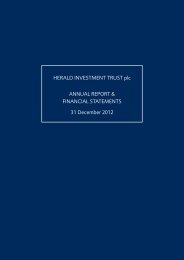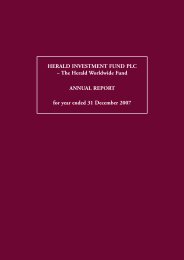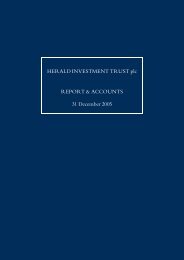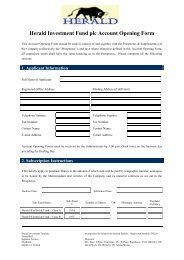HERALD INVESTMENT TRUST plc ANNUAL REPORT ...
HERALD INVESTMENT TRUST plc ANNUAL REPORT ...
HERALD INVESTMENT TRUST plc ANNUAL REPORT ...
Create successful ePaper yourself
Turn your PDF publications into a flip-book with our unique Google optimized e-Paper software.
NOTES TO THE FINANCIAL STATEMENTS continued<br />
19. Contingent liabilities, guarantees and financial commitments<br />
At 31 December 2010 and 31 December 2009 the Company had a commitment to participate in Herald Ventures II<br />
Limited Partnership. The Company’s commitment is limited to £3 million, drawn down in tranches. The first tranche<br />
was drawn down in October 2004, with a total of £2,400,000 being drawn down at 31 December 2009 with a further<br />
£300,000 in the year to 31 December 2010. The commitment will be fully drawn down in June 2011.<br />
20. Capital management<br />
The Company does not have any externally imposed capital requirements. The capital of the Company is the<br />
Ordinary share capital and reserves as detailed in notes 14 and 15. It is managed in accordance with its investment<br />
policy in pursuit of its investment objective, both of which are detailed on page 22, and shares may be repurchased<br />
as explained on page 29.<br />
21. Financial instruments<br />
In accordance with the corporate objective of maximising capital appreciation the Company invests in securities on a<br />
worldwide basis. The Company makes use of gearing to achieve improved performance in rising markets and has an<br />
interest rate swap, the purpose of which is to hedge the variability in cash flows arising from interest rate fluctuations<br />
on bank loans. The Company’s other financial instruments consist of cash, short term debtors and creditors.<br />
The main risks arising from the Company’s financial instruments are:<br />
A. Market Risk<br />
(i) Other price risk, being the risk that the value of investment holdings will fluctuate as a result of changes<br />
in market prices caused by factors other than interest rate or currency rate movement.<br />
(ii) Interest rate risk, being the risk that the future cash flows of a financial instrument will fluctuate because<br />
of changes in market interest rates; and<br />
(iii) Foreign currency risk, being the risk that the fair value or future cash flows of a financial instrument will<br />
fluctuate because of changes in foreign exchange rates.<br />
B. Credit Risk, being the risk that one party to a financial instrument will cause a financial loss for the other party<br />
by failing to discharge an obligation.<br />
C. Liquidity Risk, being the risk that an entity will encounter difficulty in meeting obligations associated with<br />
financial liabilities.<br />
These risks and the policy for managing them have been applied throughout the year and are summarised below.<br />
Further detail is contained in the Business Review – Investment Policy section on page 22.<br />
A. Market Risk<br />
(i) Other Price Risk<br />
The Company’s investment portfolio is exposed to market price fluctuations which are monitored by the<br />
Manager in pursuance of the corporate objective. Securities held by the Company are valued at bid prices,<br />
whereas material unlisted investments are valued by the Directors on the basis of the latest information in<br />
line with the relevant principles of the International Private Equity and Venture Capital Valuation Guidelines<br />
(Accounting Policy (b)). These valuations also represent the fair value of the investments, see note 10<br />
on pages 43 and 44.<br />
A full list of the Company’s investments is given on pages 16 to 20. In addition, a geographical analysis of<br />
the portfolio, an analysis of the investment portfolio by broad industrial or commercial sector and a review<br />
of the 20 largest equity investments by their aggregate market value, are shown on pages 12 to 15.<br />
Other Price Risk Sensitivity<br />
33.4% of the Company’s equity investments at 31 December 2010 (2009 – 34.7%) were listed on the<br />
main list of the London Stock Exchange and a further 31.2% (2009 – 27.9%) on AIM. The NASDAQ Stock<br />
Exchange accounts for 25.3% (2009 – 23.9%) and other stock exchanges 9.4% (2009 – 12.6%). A 10%<br />
increase in stock prices at 31 December 2010 would have increased total net assets and net return on<br />
ordinary activities after taxation by £47,500,000 (2009 – £35,000,000). A decrease of 10% would have<br />
had an equal but opposite effect. The portfolio does not target any exchange as a comparative index, and<br />
the performance of the portfolio has a low correlation to generally used indices.<br />
The shares of Herald Investment Trust <strong>plc</strong> have an underlying NAV per share. The NAV per share of Herald<br />
Investment Trust <strong>plc</strong> fluctuates on a daily basis. In addition, there is volatility in the discount/premium the<br />
share price has to NAV.<br />
<strong>HERALD</strong> <strong>INVESTMENT</strong> <strong>TRUST</strong> <strong>plc</strong> 47








